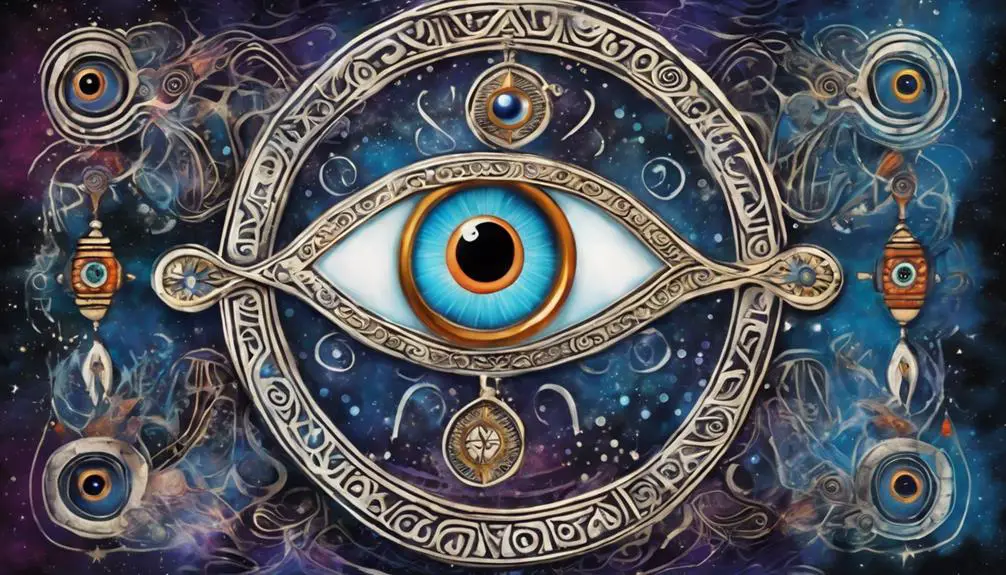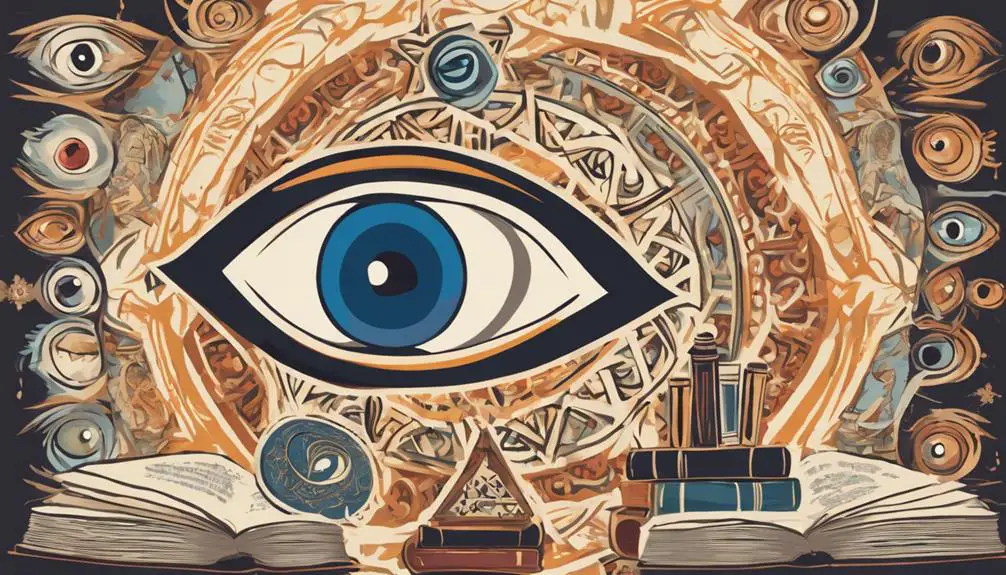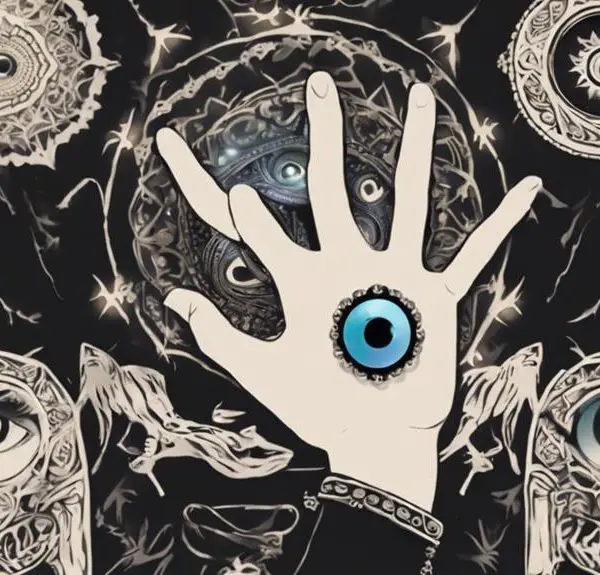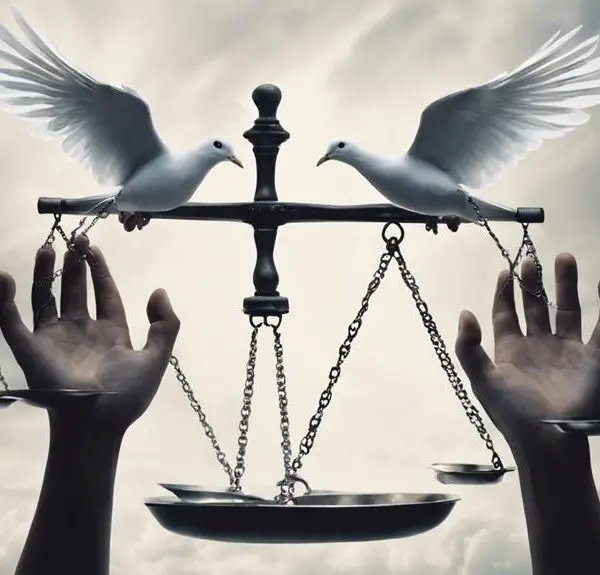Hovering between protection and superstition, does wearing an evil eye align with or challenge your spiritual beliefs? Uncover the truth within.

Is Wearing an Evil Eye a Sin?
Navigating the waters of tradition and faith can often feel like walking a tightrope, especially when it comes to the topic of wearing an evil eye. You've probably seen this symbol adorning necklaces, bracelets, and even doorways, but have you ever paused to consider whether it aligns or conflicts with your spiritual beliefs?
This discussion aims to peel back the layers of its origins, symbolism across cultures, and how various religious doctrines view this enigmatic symbol. By understanding its historical context and examining potential spiritual conflicts, you'll be better equipped to decide where you stand on this divisive issue.
Key Takeaways
- Religious views on the evil eye vary, with some seeing it as superstition and others acknowledging its significance.
- Reliance on amulets like the evil eye can conflict with the belief in divine protection in certain religions.
- Understanding the cultural and historical context of the evil eye is crucial to avoid cultural appropriation.
- Self-reflection on personal beliefs and motivations is essential when incorporating symbols like the evil eye into one's life.
The Origins of the Evil Eye

Tracing back thousands of years, the concept of the evil eye holds a rich history rooted in various cultures across the globe, serving as a testament to humanity's enduring belief in the power of malevolent gazes. You'll find that ancient beliefs regarding the evil eye share a common thread; they all recognize it as a potent curse, believed to cause harm or bad luck to those it targets, merely through a venomous look. This belief underscores the universal fear and acknowledgment of the influence of negative energies and intentions.
To counteract the feared consequences of the evil eye, protective amulets emerged as a widespread remedy. These amulets, symbols of ancient wisdom and guardians against harm, were crafted with care and imbued with the hope of deflecting malevolent glares. You'd observe that across different civilizations, the materials, designs, and rituals surrounding these amulets varied, yet their core purpose remained steadfast: to offer protection and peace of mind to those who bore them. This ancient practice highlights humanity's innate desire to shield itself from unseen forces, relying on the tangible power of protective symbols to navigate a world filled with both seen and unseen dangers.
Symbolism Across Cultures
Across various cultures, the symbolism of the evil eye amulet diverges significantly, yet it consistently serves as a beacon of protection against malevolent forces. This universal symbol's roots are deeply embedded in the history of numerous civilizations, each interpreting its power and significance in slightly different ways. However, the core belief remains unaltered: it's a shield against negativity, often realized through envy or malevolent glares.
In your journey to understand this phenomenon, it's crucial to approach the topic with sensitivity towards cultural appropriation. The term refers to adopting elements of one culture by members of another, often without understanding or respecting the original context and significance. While protective amulets like the evil eye are widely recognized and utilized across borders, it's important to recognize and honor their cultural origins and meanings.
Respecting these amulets' roots involves more than just wearing them as fashionable accessories; it encompasses a deeper appreciation and acknowledgment of their historical and cultural significance. By doing so, you're not only embracing a symbol of protection but also fostering a sense of global cultural respect and understanding.
Religious Doctrines Examined

When examining the views of various religious doctrines on the use of the evil eye amulet, it's crucial to understand that interpretations and acceptances vary significantly. The exploration of these varied perspectives uncovers a rich tapestry of beliefs surrounding the moral implications and protection ethics of wearing such an amulet.
- Christianity: Some denominations may view the evil eye amulet as superstition, potentially conflicting with the belief in divine protection.
- Islam: While belief in the evil eye is acknowledged, reliance on amulets can sometimes be seen as conflicting with the reliance on Allah for protection.
- Judaism: The Kabbalah mentions the evil eye, and its symbolism is integrated into some cultural practices, with a focus on ethical living as a protection.
- Hinduism: The concept of 'Drishti' (evil eye) is acknowledged, and protective symbols are culturally integrated without significant religious opposition.
- Buddhism: The emphasis is on internal spiritual development for protection, with less focus on external symbols like the evil eye amulet.
These perspectives highlight the nuanced positions religions hold towards the evil eye amulet, reflecting broader themes of faith, protection, and the intersection of cultural practices with religious doctrine.
Potential Spiritual Conflicts
Delving into the realm of potential spiritual conflicts, it's imperative to consider how reliance on the evil eye amulet may intersect with core religious beliefs, potentially leading to internal dilemmas for adherents. This intersection raises profound questions about cultural appropriation and the psychological effects associated with adopting symbols from cultures not one's own.
Aspect |
Impact on Believers |
Emotional Resonance |
|---|---|---|
Cultural Appropriation |
Diminished authenticity |
Confusion and guilt |
Psychological Effects |
Anxiety over protection |
Fear and dependency |
Religious Conflict |
Doubt in one's faith |
Inner turmoil |
Community Perception |
Social isolation |
Loneliness |
Personal Identity |
Erosion of self |
Disconnection |
Wearing the evil eye without understanding its cultural and religious significance can lead to an erosion of personal identity and a sense of disconnection, not only from one's own culture but also from the broader spiritual community. Furthermore, the psychological effects of relying on such amulets for protection can foster a dependency that detracts from the development of personal resilience and faith. This complex interplay of factors underscores the need for a thoughtful examination of one's motivations and beliefs when choosing to incorporate such symbols into one's life.
Navigating Faith and Tradition

Understanding the complex relationship between personal beliefs and cultural traditions is essential as you explore the significance of wearing an evil eye amulet within your faith. This intersection often involves navigating a fine line between respecting traditions and aligning with personal beliefs. It's crucial to approach this topic with both an analytical mind and a respectful demeanor, especially when considering the potential for cultural appropriation.
- A handcrafted evil eye amulet hanging in a market stall, symbolizing centuries of tradition.
- A family heirloom passed down through generations, embodying personal beliefs intertwined with cultural heritage.
- A fashion statement on a celebrity, sparking debates about cultural appropriation.
- An individual in silent prayer, seeking protection while wearing an evil eye, illustrating the fusion of faith and tradition.
- A discussion in a religious study group, examining the amulet's meaning from various theological perspectives.
To navigate this terrain effectively, you should consider:
- The origins and history of the evil eye amulet within the culture you're borrowing from.
- The potential impact of your choices on communities associated with the evil eye tradition.
- How your personal beliefs align or conflict with the symbolism and intended use of the amulet.
Frequently Asked Questions
Can Wearing an Evil Eye Amulet Impact Personal Relationships or Social Interactions in Significant Ways?
Wearing an evil eye amulet can affect your social interactions, depending on cultural appropriation and symbolic interpretation. You'll need to consider others' perceptions and the amulet's significance within various cultural contexts to navigate relationships respectfully.
Are There Any Reported Psychological Effects, Positive or Negative, Associated With Believing in or Wearing an Evil Eye?
Believing in or wearing an evil eye can lead to cognitive dissonance or a placebo effect, affecting your mental state. You might feel protected or face inner conflict, shaping your psychological experience.
How Do Contemporary Fashion and Design Industries Influence the Perception and Use of the Evil Eye Symbol?
Today's fashion and design sectors significantly impact how you view and utilize the evil eye symbol, often blurring lines between cultural appropriation and trend adaptation, while reshaping its traditional meanings and significance.
Is There a Difference in the Effectiveness of an Evil Eye Amulet Based on Its Material or Color?
You'll find that material significance and color symbolism deeply impact an evil eye amulet's effectiveness. Scholars argue these elements carry distinct energies, influencing how well the amulet protects against malevolent gazes and intentions.
What Are the Ethical Considerations in Commercializing and Selling Evil Eye Ornaments, Especially by Those Who May Not Understand or Respect Its Cultural Significance?
You should consider how commercializing evil eye ornaments without understanding their cultural significance might border on cultural appropriation. Market saturation could dilute their traditional value, raising ethical concerns about respect and cultural sensitivity.
Conclusion
In conclusion, wearing an evil eye symbol, while deeply rooted in various cultural traditions, necessitates a thoughtful examination of one's personal beliefs and religious doctrines. It's crucial to consider potential spiritual conflicts and respect the nuances of differing interpretations.
As you navigate your faith and tradition, understand that the symbolism of the evil eye transcends a simple accessory, reflecting broader historical and spiritual dimensions. Hence, the decision to wear it should be approached with both reverence and critical analysis.



Sign up